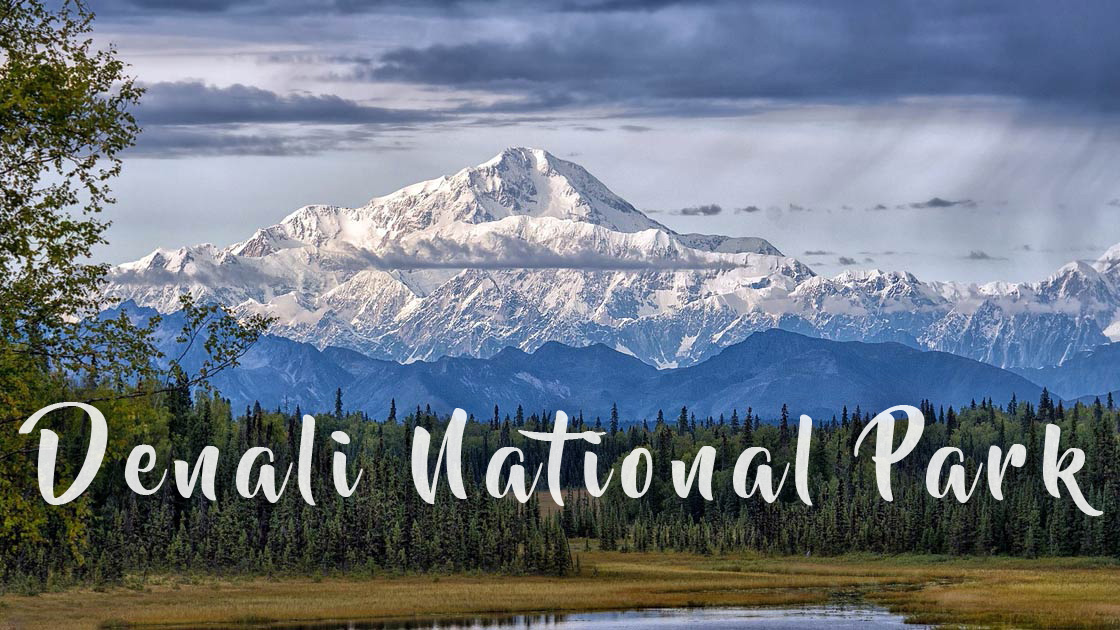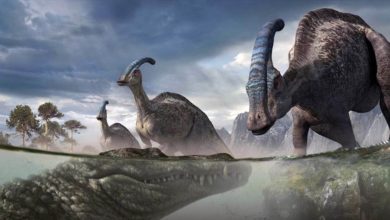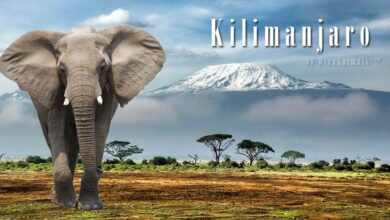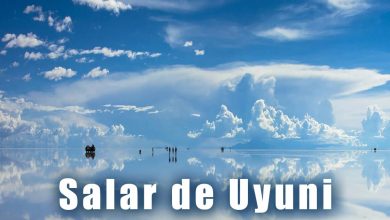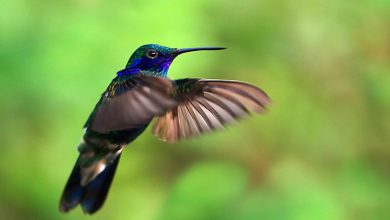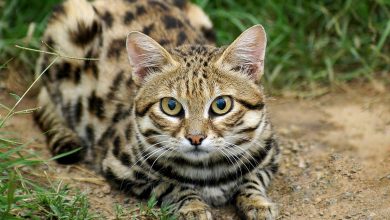Denali National Park & Preserve: Exploring One of America’s Greatest National Parks
Nestled in the heart of the rugged Alaskan wilderness, Denali National Park and Preserve is a place of awe-inspiring beauty and unparalleled adventure. With its towering mountains, pristine rivers, and diverse wildlife, this sprawling six-million-acre park offers visitors a glimpse into the raw power and majesty of nature. From the summit of Denali, the highest peak in North America, to the vast glaciers that carve their way through the landscape, there is no shortage of wonders to be found here. Whether you’re an avid hiker, a wildlife enthusiast, or simply looking for a chance to disconnect and recharge, Denali National Park and Preserve is a destination that truly has it all.
Denali National Park and Preserve is a national park and preserve in Alaska, United States. The park is home to the highest mountain in North America, Denali (formerly known as Mount McKinley), which is 20,310 feet (6,190 m) high. The park encompasses more than six million acres of pristine wilderness, including glaciers, tundra, and forests. It is also home to a diverse array of wildlife, including grizzly bears, wolves, caribou, moose, and Dall sheep. Visitors can explore the park through hiking, camping, and backpacking, as well as by taking guided bus tours or flightseeing tours. The park is open year-round, but access to the park road and some facilities is limited during the winter months.
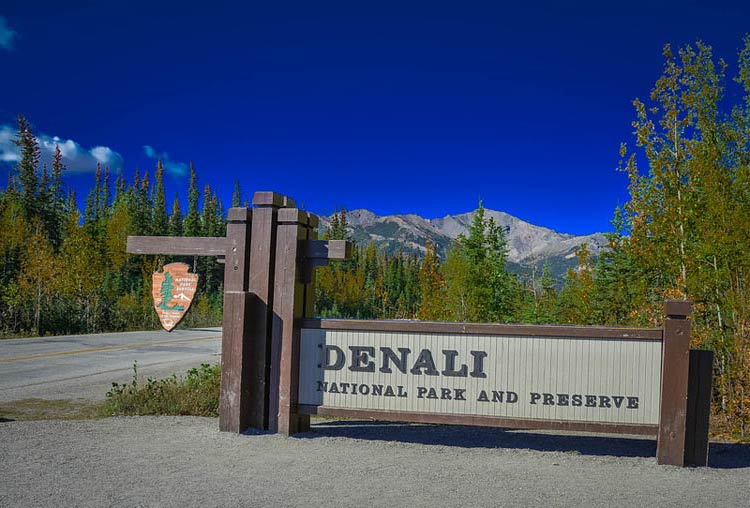
Location
Denali National Park and Preserve is located in the Interior region of Alaska, United States. It is situated about 240 miles (386 km) north of Anchorage and can be accessed by car or by taking a combination of train and bus from Anchorage or Fairbanks. The park is bordered by the George Parks Highway to the south and the Richardson Highway to the east. The nearest towns to the park are Healy, Cantwell, and Nenana.
Basic Facts About Denali National Park and Preserve
- Location
Denali National Park and Preserve is located in central Alaska, about 240 miles north of Anchorage. - Size
The park covers over 6 million acres (24,500 km²) of land, making it one of the largest national parks in the United States. - Highest peak
The highest peak in North America, Denali (formerly known as Mount McKinley), is located in the park and stands at an elevation of 20,310 feet (6,190 m). - Wildlife
Denali National Park and Preserve is home to a wide variety of wildlife, including grizzly bears, black bears, moose, caribou, Dall sheep, wolves, lynx, and wolverines. - Climate
The park has a unique arctic and subarctic climate, characterized by long, cold winters and short, mild summers. - Access
The park has limited road access, and the only way to see the park is by taking a park bus, or by hiking or backpacking. - Main activities
The park offers a wide variety of activities for visitors, including hiking, backpacking, wildlife viewing, and mountaineering. - Glaciers
Denali National Park and Preserve is home to several glaciers, including the Kahiltna Glacier which is the main starting point for climbers attempting to summit the mountain, and the Muldrow Glacier which is the longest glacier in the park.
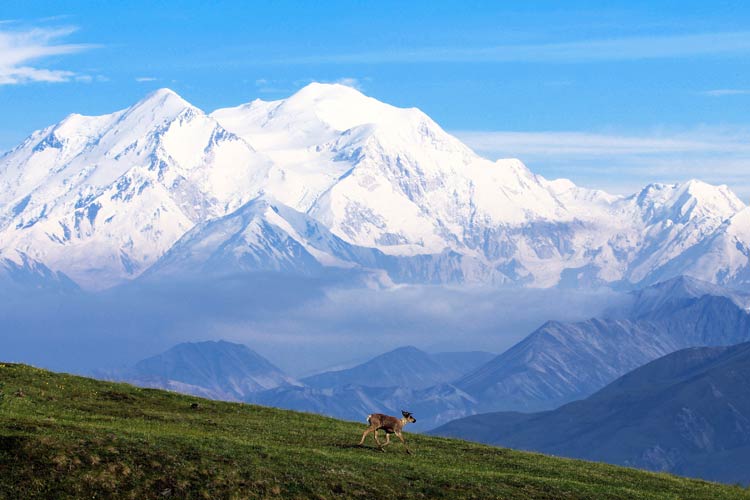
History and name of the Park
Denali National Park and Preserve was established as Mount McKinley National Park on February 26, 1917 by President Woodrow Wilson. The park was created to protect the area around Denali (formerly known as Mount McKinley), the highest mountain in North America, and its unique wilderness and wildlife.
The park was initially created to protect the mountain and its immediate surroundings, but it was later expanded to include more of the surrounding wilderness. In 1980, the park’s name was changed from Mount McKinley National Park to Denali National Park and Preserve, to reflect the name of the mountain used by the local Athabascan people, which means “The High One” or “The Great One”
The park preserves more than 4 million acres of wilderness, with the mountain and its immediate surroundings accounting for only a small portion of the park’s total area. The park contains several distinct ecosystems, including tundra, boreal forest, and glaciers, and is home to a wide variety of wildlife, including grizzly bears, wolves, caribou, moose, and Dall sheep.
The park is also an important cultural site for the local Athabascan people, who have lived in the area for thousands of years and continue to use the park for hunting, fishing, and other traditional activities.

Geography
Denali National Park and Preserve is located in the Interior region of Alaska, United States and encompasses more than six million acres of pristine wilderness. The park is characterized by its rugged terrain, which includes the highest peak in North America, Denali, which stands at 20,310 feet (6,190 m) tall. The mountain is the centerpiece of the park and can be seen from many different viewpoints throughout the park.
The park’s terrain is diverse and includes glaciers, tundra, and forests. The park is home to several glaciers, including the Kahiltna, Muldrow, and Ruth glaciers. The tundra is characterized by its rolling hills, rocky outcroppings, and low-growing vegetation, while the forests are primarily made up of spruce, birch, and aspen trees.
The park is situated in the transition zone between the boreal forest and the Arctic tundra, and is home to a wide variety of wildlife, including grizzly bears, wolves, caribou, moose, and Dall sheep. The park also contains several rivers and streams, including the Nenana River, the Kantishna River, and the Teklanika River, which provide important habitat for fish and other aquatic species.
The park’s location in the Interior region of Alaska also means that it experiences extreme temperatures and long, dark winters. The park is open year-round, but access to the park road and some facilities is limited during the winter months.
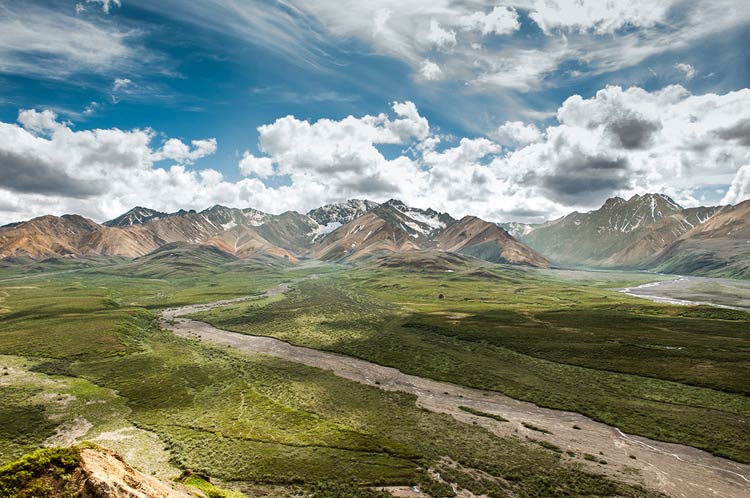
Geology
The geology of Denali National Park and Preserve is characterized by the presence of the Denali, the highest peak in North America, which is composed of granite and schist. The mountain formed around 60 million years ago as a result of tectonic activity that caused the uplift of the region. The mountain’s height and location in the Interior of Alaska means that it is covered by several glaciers, including the Kahiltna, Muldrow, and Ruth glaciers. These glaciers have sculpted the mountain’s slopes and created several valleys and cirques.
The park’s terrain is also characterized by its rocky outcroppings, which are made up of a variety of different rock types, including granite, schist, and sandstone. The park’s tundra is underlain by a layer of permafrost, which has played a significant role in shaping the park’s landscape by creating patterned ground and other permafrost-related features.
The park is also home to several active and extinct volcanic features, including the Valley of Ten Thousand Smokes, which is an ash-filled valley created by the eruption of the Novarupta volcano in 1912. The eruption was one of the largest volcanic eruptions of the 20th century and created an ash deposit that covers an area of more than 100 square miles. The eruption also created volcanic ash that covered most of the park, and created unique and fascinating landscapes, as well as a unique ecosystem.
The geology of Denali National Park and Preserve is diverse and complex, shaped by a variety of geological processes and featuring a wide range of rock types, landforms, and other geologic features.

Mineral deposits
Denali National Park and Preserve is known to have mineral deposits, including gold, coal, and other metals. However, the park’s resources are protected under federal law, and any mining or extraction activities are strictly prohibited within the park’s boundaries. The park’s wilderness and natural resources are considered too valuable to be exploited, and the focus is on preserving the park for its natural, cultural, and recreational values. Therefore, any mineral deposits within the park remain untouched and undisturbed.
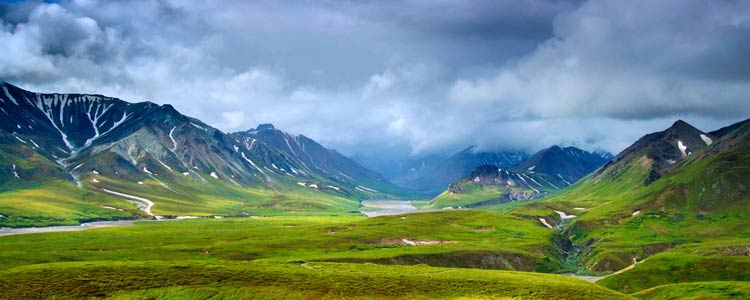
Glaciers
Denali National Park and Preserve is home to several glaciers, including the Kahiltna Glacier which is one of the longest glaciers in the Alaska Range. The Kahiltna Glacier is located on the south side of Denali and is the main starting point for climbers attempting to summit the mountain.
The Muldrow Glacier is another notable glacier that can be found in the park. It is located on the north side of Denali and is the longest glacier in the park, stretching over 27 miles (43 km) in length. The Muldrow Glacier is also the location of the park’s headquarters and is a popular spot for visitors to view the mountain and the glacier.
The Ruth Glacier is also located in the park, it is one of the most heavily glaciated valleys in the world. It is also a popular spot for backcountry skiers and mountaineers, as well as for helicopter tour companies.
Glaciers are important features of the park, and they are a significant source of water for the park’s rivers and streams. They also shape the landscape and create unique features such as glacial valleys, moraines, and cirques. However, it’s worth noting that glaciers worldwide are melting rapidly due to climate change, and the glaciers in Denali National Park and Preserve are no exception. This can have a number of negative impacts on the park’s ecosystem, and it’s important that we work to reduce our greenhouse gas emissions to slow down the rate of glacial melting.

Climate
The climate of Denali National Park and Preserve is subarctic and characterized by long, cold winters and short summers. The park experiences significant temperature variations due to its high elevation and location in the Interior of Alaska.
- During the summer months, the park typically experiences temperatures ranging from the low 40s F (5 C) at night to the low 60s F (15 C) during the day. However, temperatures can fluctuate widely and can reach above 80 F (27 C) on some days. The park also receives a moderate amount of precipitation during the summer months, primarily in the form of rain, but also some snowfall.
- The winter months are much colder and darker, with temperatures typically ranging from -20 F (-29 C) to -40 F (-40 C) during the day and even colder at night. The park also receives significant snowfall during the winter, with some areas receiving more than 20 feet (6 m) of snow.
The park also experiences strong winds throughout the year, particularly in the high elevations near Denali, which can make outdoor activities challenging.
The park’s climate is harsh, but the park is open year-round. Visitors should be prepared for extreme temperatures, snow, and wind, and should be aware that access to the park road and some facilities is limited during the winter months.
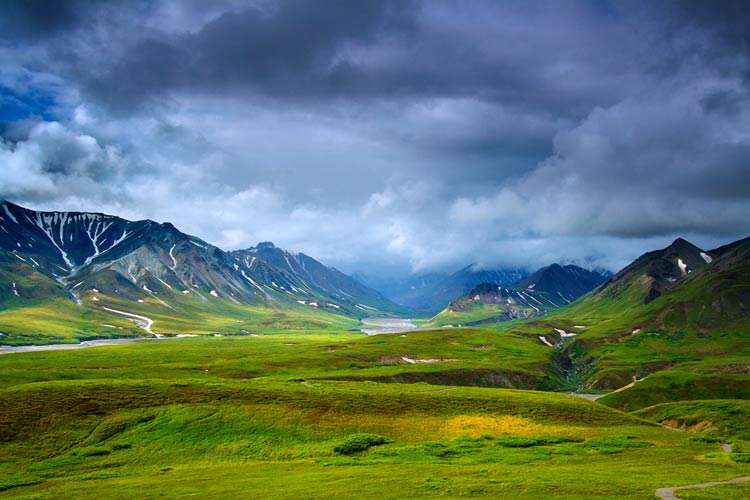
Flora in Denali National Park and Preserve
The flora of Denali National Park and Preserve is diverse and adapted to the harsh subarctic climate. The park is situated in the transition zone between the boreal forest and the Arctic tundra, and as a result, it is home to a wide variety of plant life.
- The park’s lower elevations are primarily characterized by the presence of spruce, birch, and aspen forests. These forests are typically made up of black spruce, white spruce, and paper birch, as well as aspen and willow. The understory of these forests is typically made up of a variety of different shrubs and herbs, including dwarf birch, Labrador tea, and blueberries.
- The park’s higher elevations are characterized by the presence of tundra, which is a treeless landscape that is characterized by low-growing vegetation and rocky outcroppings. The park’s tundra is home to a variety of different plant species, including mosses, lichens, and grasses, as well as a wide variety of different flowers, such as the arctic poppy, arctic forget-me-not, and alpine forget-me-not.
- The park is also home to several wetlands, including bogs and fens, which are home to a variety of different plant species, including cranberries, cloudberries, and Labrador tea.
The flora of Denali National Park and Preserve is diverse and adapted to the harsh subarctic climate. It’s a unique opportunity to see how the different species of plants thrive in such a challenging environment. Visitors can also enjoy the different colorful wildflowers during the summer months.

Fauna in Denali National Park and Preserve
The fauna of Denali National Park and Preserve is diverse and includes a wide variety of different animal species that are adapted to the subarctic climate. The park is home to a wide variety of different mammals, birds, fish, and invertebrates.
Mammals that can be found in the park include grizzly bears, black bears, moose, caribou, Dall sheep, wolves, lynx, wolverines, beavers, and otters. The park is also home to several species of small mammals, including the Arctic ground squirrel, the red squirrel, and the least chipmunk.
Birds are also abundant in the park, with over 280 species being recorded. Some of the most notable bird species that can be found in the park include the golden eagle, the bald eagle, the gyrfalcon, the peregrine falcon, the rock ptarmigan, the willow ptarmigan, the gray jay, and the common raven.
The park is also home to several species of fish, including arctic grayling, lake trout, and northern pike, as well as several species of amphibians and reptiles, including the wood frog and the northern leopard frog.
The park is also home to a wide variety of invertebrates, including insects, spiders, and other arthropods. These include mosquitoes, black flies, and other biting insects, as well as a wide variety of different butterflies and moths.
Overall, the fauna of Denali National Park and Preserve is diverse and includes a wide variety of different animal species that are adapted to the subarctic climate. Visitors can spot many of these animals during their visit, but it’s important to remember that wildlife viewing should be done from a safe distance and to respect the wild animals and their habitat.
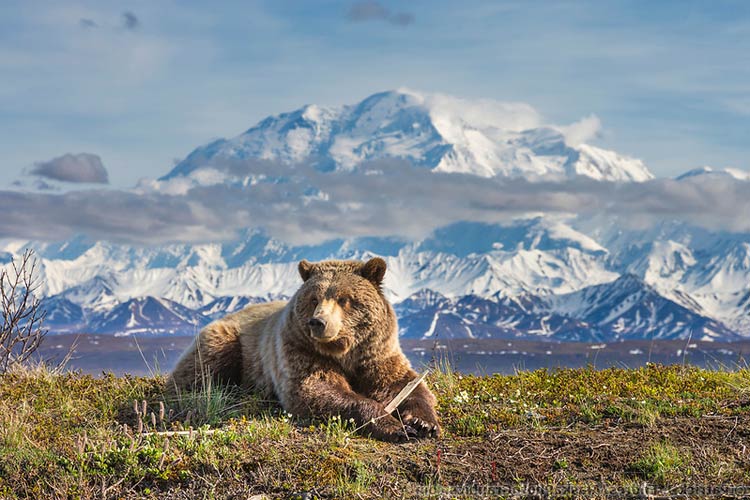
Tourism and tourist main attractions in the park
Denali National Park and Preserve is a popular tourist destination and offers a wide variety of different activities and attractions for visitors to enjoy.
- The main attraction of the park is, of course, Denali, the highest peak in North America, which towers over the park at an elevation of 20,310 feet (6,190 m). Visitors can take a bus tour to the park’s Kantishna Roadhouse, which is the farthest point that the park road goes, and offers views of the mountain from a distance.
- Another popular activity is hiking and backpacking, as the park offers a wide variety of different trails that range from easy, short hikes to more challenging, multi-day backpacking trips. The park also offers guided backpacking trips for those who want a more in-depth experience.
- The park is also popular among wildlife viewing enthusiasts, as it is home to a wide variety of different animals, including grizzly bears, black bears, moose, caribou, Dall sheep, wolves, lynx, and wolverines. Visitors can also take a bus tour that goes deeper into the park to increase their chances of seeing the wildlife.
- The park also offers a wide variety of ranger-led programs and educational activities, such as campfire talks, guided hikes, and wildlife viewing tours. The park also has a visitor center where visitors can learn more about the park’s history, geology, and wildlife.
Denali National Park and Preserve is a popular tourist destination that offers a wide variety of different activities and attractions for visitors to enjoy. From wildlife viewing, hiking, backpacking, ranger-led programs, to the main attraction, Denali, the highest peak in North America, visitors can have a unique and memorable experience.
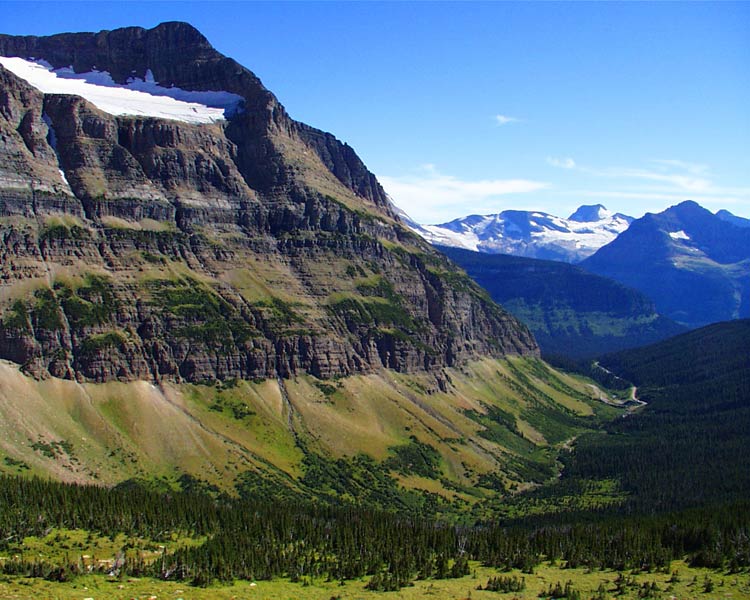
How To Reach To Denali National Park and Preserve
There are several ways to reach Denali National Park and Preserve, depending on your location and mode of transportation. Here are some common ways to get there:
- By air
The nearest major airport to Denali National Park and Preserve is Ted Stevens Anchorage International Airport in Anchorage, Alaska. From there, you can take a smaller plane to the park’s private airstrip, located just outside the park entrance. - By car
If you are driving from Anchorage, take the George Parks Highway (also known as Highway 3) north for about 240 miles until you reach the park entrance. - By train
The Alaska Railroad operates daily passenger service to Denali National Park and Preserve from Anchorage, Fairbanks, and other locations in Alaska. The park’s train depot is located just inside the park entrance. - By bus
Several private companies offer bus tours to Denali National Park and Preserve from Anchorage, Fairbanks, and other locations in Alaska.
Once you arrive at the park, the only way to see the park is by taking a park bus, hiking or backpacking. It is important to note that the park has limited road access, and private vehicles are not allowed beyond the park entrance.

Best Time To Visit Denali National Park and Preserve
The best time to visit Denali National Park and Preserve depends on your interests and what you want to do in the park. Here’s an overview of the seasons and what you can expect during each one:
- Summer (June – August)
This is the peak tourist season in Denali National Park and Preserve, with long days and mild temperatures. During this time, visitors can take advantage of a variety of activities, including hiking, wildlife viewing, mountaineering, and ranger-led programs. However, be prepared for larger crowds and higher prices during this time. - Fall (September – October)
This is a quieter time in the park, with cooler temperatures and shorter days. However, the fall foliage is spectacular, and wildlife such as moose and caribou are often easier to spot as they prepare for winter. Also, during the fall season, there is a greater chance of seeing the Northern Lights. - Winter (November – March)
Denali National Park and Preserve is mostly closed during the winter, but there are still plenty of activities to enjoy, such as cross-country skiing, snowshoeing, and dog sledding. The park also offers winter wildlife viewing opportunities, as many animals are more active during this time. - Spring (April – May)
The park begins to thaw out during the spring, with longer days and milder temperatures. The park is not yet open for summer activities, but visitors can still enjoy hiking, birdwatching, and other outdoor activities.
The best time to visit Denali National Park and Preserve depends on your interests, as each season offers its own unique experiences.

Denali National Park and Preserve in numbers
Here are some numbers that help to give a sense of the scale and significance of Denali National Park and Preserve:
- Size
Denali National Park and Preserve covers over 6 million acres (2.4 million hectares) of land, making it larger than the state of Massachusetts. - Elevation
The park’s highest point is the summit of Denali (formerly known as Mount McKinley), which stands at 20,310 feet (6,190 meters) above sea level. - Visitors
The park receives approximately 600,000 visitors each year. - Wildlife
Denali National Park and Preserve is home to over 37 species of mammals, including grizzly bears, moose, caribou, wolves, and Dall sheep. - Birds
The park is also a popular destination for birdwatching, with over 170 species of birds recorded in the park. - Glaciers
The park has over 2,000 glaciers covering more than one million acres (400,000 hectares) of land. - Road access
The park has only one road, which is 92 miles (148 kilometers) long and extends from the park entrance to Kantishna. - Hiking trails
The park has over 90 hiking trails, covering a total of 415 miles (668 kilometers) of land. - Wilderness
Over 2 million acres (810,000 hectares) of Denali National Park and Preserve have been designated as wilderness areas, meaning they are protected and preserved in their natural state.
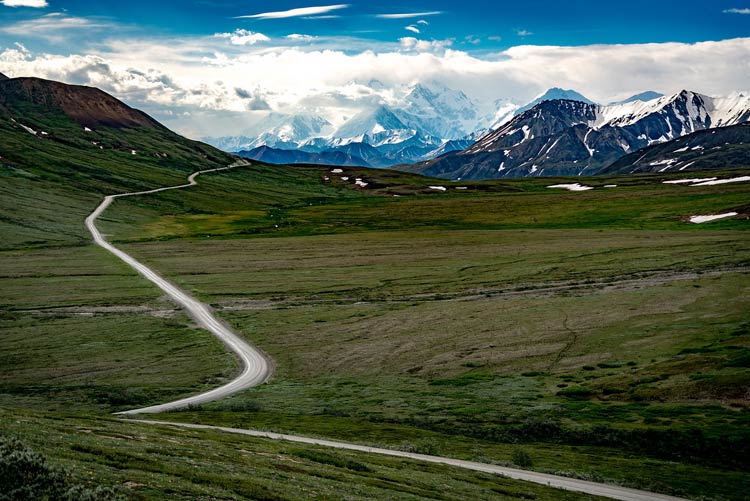
Interesting facts about Denali National Park and Preserve
- Denali National Park and Preserve is home to the highest peak in North America, Denali (formerly known as Mount McKinley), which stands at an elevation of 20,310 feet (6,190 m).
- The park is located in the interior of Alaska and covers an area of over 6 million acres, making it one of the largest national parks in the United States.
- The park was first established as Mount McKinley National Park in 1917, and it was later renamed Denali National Park and Preserve in 1980.
- The park is home to a wide variety of wildlife, including grizzly bears, black bears, moose, caribou, Dall sheep, wolves, lynx, and wolverines.
- The park offers a wide variety of activities for visitors, including hiking, backpacking, wildlife viewing, and mountaineering.
- The park’s main road, Denali Park Road, is only 148 km (92 miles) long, but it is the only road that goes into the park.
- The park has limited road access, and the only way to see the park is by taking a park bus, or by hiking or backpacking.
- The park has a unique arctic and subarctic climate, characterized by long, cold winters and short, mild summers.
- Denali park is home to several glaciers, including the Kahiltna Glacier which is the main starting point for climbers attempting to summit the mountain, and the Muldrow Glacier which is the longest glacier in the park.
- The park is also home to the highest airport in North America, the Talkeetna Airport, which is located at an elevation of 2,000 feet.
- Denali National Park and Preserve is home to the headquarters of the National Park Service’s Arctic Network, which manages eight national park sites in Alaska.
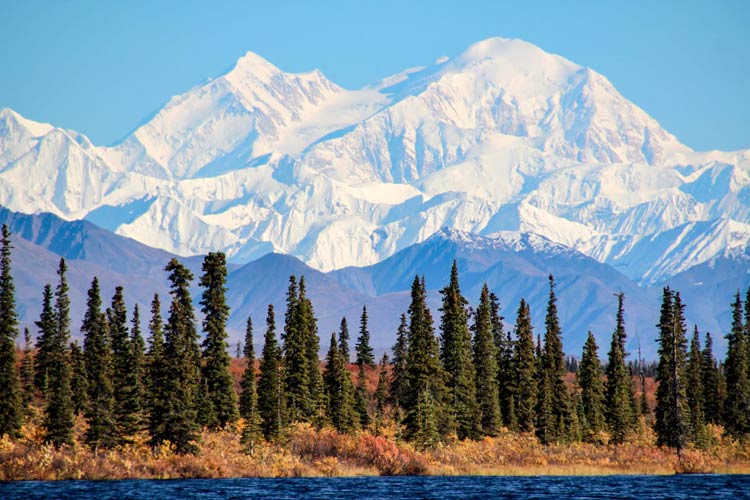
Q&A (questions and answers) about Denali National Park and Preserve
Q: How big is Denali National Park and Preserve?
A: Denali National Park and Preserve covers an area of over 6 million acres, making it one of the largest national parks in the United States.
Q: What is the highest peak in Denali National Park and Preserve?
A: The highest peak in the park is Denali (formerly known as Mount McKinley), which stands at an elevation of 20,310 feet (6,190 m).
Q: What kind of wildlife can be found in the park?
A: Denali National Park and Preserve is home to a wide variety of wildlife, including grizzly bears, black bears, moose, caribou, Dall sheep, wolves, lynx, and wolverines.
Q: What activities are available for visitors in the park?
A: The park offers a wide variety of activities for visitors, including hiking, backpacking, wildlife viewing, and mountaineering.
Q: Is there a road that goes through the park?
A: The park’s main road, Denali Park Road, is only 148 km (92 miles) long, but it is the only road that goes into the park. The park has limited road access, and the only way to see the park is by taking a park bus, or by hiking or backpacking.
Q: What is the climate like in the park?
A: The park has a unique arctic and subarctic climate, characterized by long, cold winters and short, mild summers.
Q: How many glaciers are in the park?
A: Denali park is home to several glaciers, including the Kahiltna Glacier which is the main starting point for climbers attempting to summit the mountain, and the Muldrow Glacier which is the longest glacier in the park.
Q: What is the highest airport in North America?
A: The highest airport in North America is the Talkeetna Airport, which is located at an elevation of 2,000 feet and is within the park.


